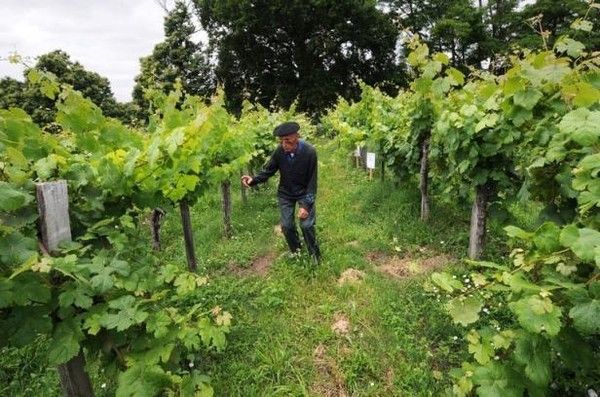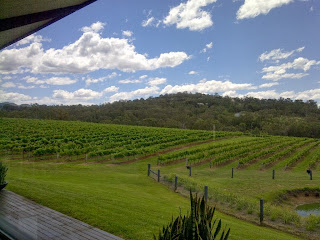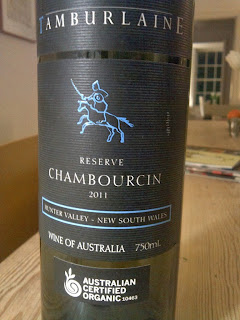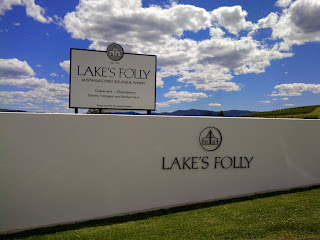After Melbourne it was Sydney and the opportunity, finally to visit our beloved Hunter Valley; Australia's oldest-established wine region and the nearest to Sydney. Why beloved? Because we adore and admire Australia's truly original contribution to the great wines of the world, Hunter Valley Semillon. Still amazingly little known and under-appreciated (although almost never underpriced), Hunter Valley Semillon has unexplained magical properties which distinguish it from all other wines. For starters it is light and low in alcohol (the vast majority are of 10% and 11%) and yet it is astonishingly age-worthy. The older the better really.
As if that was not enough, it never, ever sees wood and yet has a component which makes it taste as if just the right amount of oak has been used. A felicitous illusion.
We learned from Andrew Jefford that it is grown on the 'wrong' East-facing side of the valley. It must be tricky to produce. Whoever evolved this style of wine should have their name elevated to immortality some how (perhaps in the same way as the Germans call Pinot Gris Ruelander). In fact it is not known who this pioneer might have been. Semillon was planted in the Hunter Valley in the 19th century and is still the second most planted white grape after Chardonnay. It seems that what we know as distinctive Hunter Valley Semillon has been evolving over a long time from what Jancis Robinson calls 'a conjunction of quirks of nature.'
We expected there to be a wider selection of Hunter Valley Semillon in Bottle Shops but were consoled to see reasonable representation on hotel and restaurant winelists. These were not always the most famous marques: we came across the excellent small producers Margan and Andrew Thomas in this way.
The drive from Sydney is about 2 hours. After plying through many a suburb comes an attractive if uneventful freeway. Things get a bit more picturesque after turning off and passing through Cessnok (do they know their town has the same name as the word for Garlic in Russian?). Suddenly there are signs to wineries, wine trails and suchlike - all rather well organised.
We had no particular itinerary. Our plan was to head for McWilliams as it is their 2006 Sainsbury's 'Taste the difference' Hunter Valley Semillon which is Slotovino's house white (even we never tire of it).
The McWilliams place has the air of an American ranch and is set in lovelier countryside than we had been led to expect.
Someone had said the Hunter Valley was not very attractive as it had been an important coalmining area (we didn't see a single slag heap all day).
The McWilliams clan were gathering for a family wedding which made an interesting show while we took a snack at the Cellar Door Cafe and then it was to the tasting room where a couple of seasoned representatives led us through the menu.
We didn't want to taste too many wines as this was just the first of the day so we zeroed in on one at the top of the range we hadn't heard of, Phil Ryan limited release. This was a 2009 from young vines. Phil Ryan is McWilliams's Chief Winemaker from their Mount Pleasant vineyard.
Very good, as was another Mount Pleasant offering called Lovedale (2007, 11,5%).
The other speciality of Hunter Valley is Shiraz but we are at a loss to understand how producers could imagine this will ever be as interesting as the Semillon. It has no particular magical properties for a start!
Another destination was Briar Ridge if only because they have a Winemaker and Consultant there called Karl Stockhausen.
Thanks to James Halliday's 'Australian Wine Companion' we had alighted on this interesting fact and so we set our SatNav for Briar Ridge hoping to meet the famous composer's 'Namensvetter'.
 |
| Karlheinz |
 |
| Karl |
Of course Mr. Stockhausen wasn't there but we were able to buy both the Semillon and Shiraz bearing his name.
We later sent photos of these labels to Stockhausen Verlag - the composer's publishing house and they were very interested to see them. Even more strange was the fact the staff at Briar Ridge had never heard of the composer!
Properties were now coming thick and fast. Next was Lindemans, predictably big and corporate
 |
| Please wait to be seated |
with facilities for the largest coach parties,
Poole's Rock (home of Cockfighter's Ghost - not a name to inspire a whole lot of sales, surely?). Berry Bros. and Rudd stock Poole's Rock at over £40 a punt. Nice tasting room; pretty view.
Next up, Brokenwood whose wines are familiar to us from the UK,
McGuigan, just as big as Lehmann although this didn't prevent them from winning prizes such as International Winemaker of the Year, Australian Producer of the Year and International White Winemaker of the Year.
Sadly the top McGuigan wines are not available in the UK. The entry level wines are not as good as some of their rivals' and their low-alcohol wines we have found disappointing.
After such big-scale operations it was interesting to enter a compound devoted to small producers.
These included Andrew Thomas, Little Wine Co,
Margan, Hart and Hunter, David Hook, Talga, Highgate, Triggerfish and Keith Tulloch. Only this last name was familiar to us from the UK. Together, as well as Semillon and Shiraz, these producers make wine with Sauvignon, Verdelho, Vermentino, Pinot Grigio, Gewurztraminer, Traminer, Chardonnay, Sangiovese, Tempranillo, Barbera, Merlot, Cabernet Sauvignon and Moscato.
Our last tasting stop was at Tamburlaine which is Certified Organic. This was a nice and cozy operation with some interesting wines including a Chambourcin.
We snapped this up immediately having once enjoyed an Australian Chambourcin but never seeing it anywhere again. One taste and we were convinced anew of this hybrid's worth.
Lake's Folly is also in the area. This was one of the Icon wineries chosen by Oz Clarke in his book 'New Classic Wines.'
Dr. Max Lake had once tasted an Australian Cabernet Sauvignon with some Petit Verdot and in 1963, decided to start a winery devoted to these grapes and Chardonnay. He was a pioneer at that time. It was the first boutique winery in the Hunter Valley and his achievements put the Hunter back on the map. His Cabernet/Petit Verdot was at one time the most expensive wine in Australia.
They no longer grow much Petit Verdot but the winery thrives on its Cabernet Sauvignon and Chardonnay. We hadn't remembered that it was in the Hunter Valley. Our trip was full of surprises like that. There was even a De Bortoli winery over the road from Lake's Folly.
Many of these wineries have Pokolbin as their address abut there is no actual town or even village of that name. The nearest is a little collection of shops and eateries we stumbled on when making our way back to Sydney. We couldn't resist taking a look at the wares in the Winemakers' Outlet. Here we met a very nice lady who had worked in the wine world in various capacities for many years and who warmly recommended a sparkling Malbec/Shiraz from Audrey Wilkinson, one of the oldest establishments of the area (founded 1866). Audrey was a bloke by the way. The Audrey Wilkinson website introduces this fact with "What were his parents thinking?"
We bought this to give to friends in Sydney in the expectation it was something they may not have come across before.
This was one of those days which will remain in the memory. We very much hope to return and spend more time in this fascinating and beautiful area.














































































